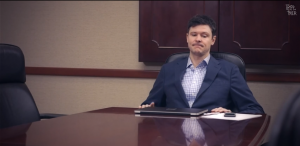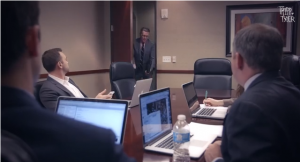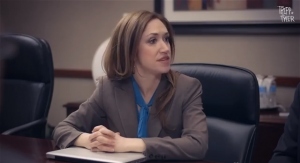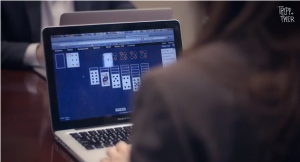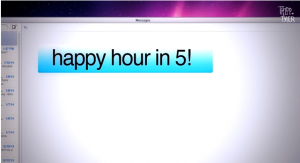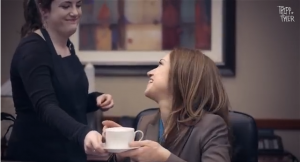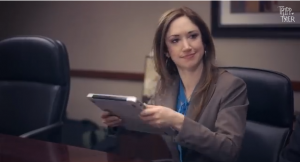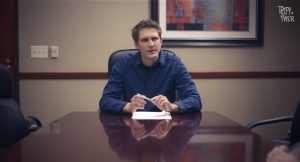You’ve all seen it circulating on social media and e-mail threads – the hilarious video, “A Conference Call in Real Life,” by Leadercast. How many of you chuckled with amazement of just how accurately the video depicts conference calls you typically attend? *Raises hand.* Everyone I know who’s commented has said words like, “Yes, this is so true!”… or… “This is EXACTLY what happens with my group!” When a co-worker forwarded it to our entire team to enjoy, I knew the video would resonate with us all – even for facilitators. Surely, we can strive for better, though, right? RIGHT. Here are 7 ways master facilitators do it better.
Think about this – what if a video on conference calls in real life looked completely different? What if the participants were actually doing simple facilitation techniques during the conference call? Imagine what would happen if that went viral – less wasted time, more productivity, and even better virtual meeting results!
Here are 7 ways you can respond to those common identities and mishaps of conference calls:
1. THE SCENE: 0:15 – Remember when Tripp Crosby was patiently waiting listening to that awful elevator music?… Begin the meeting on time.
Right off the bat, there is a wait (although only a few seconds shown here), and late arrivers are seen entering the call a bit behind. What a frustrating (and dysfunctional) way to start a meeting… Here’s how you can manage around this:
- Allow for a gathering time. Sometimes making room in the agenda for a five-minute “gathering” time leaves participants with an opportunity to hop from meeting to meeting, call to call. It sets the meeting up for success, so participants know that the meeting will start “on time” at 2:05pm instead of 2:00pm on the dot.
- Give the two-minute warning. For people who do arrive early, as a courtesy for them and their wait, let them know that the two-minute countdown is on and that the lovely hold music won’t continue on forever.
2. THE SCENE: 1:16 – Paul has trouble entering the meeting… Do your prep work.
This won’t always be perfect. You’ll always have “that guy” who doesn’t have the access code to enter a conference call or has some sort of technical hiccup that prevents him from joining the group on time. This happens. However, here’s a simple way you can lessen these instances – always communicate the meeting logistics in advance. As part of our 6 Ps of Preparation, we share that “Place” is often the most overlooked. Make sure your participants have the information they need in advance of the meeting. And, for those conference calls with many participants, consider having a moderator or “technographer” assigned to help with those inevitable technical challenges and glitches.
“Place” also becomes an important factor later in the video when Tripp assumes that Paul and the others have Macs while they experience issues with not seeing his presentation. Remember to think about the challenges your participants may encounter during virtual meetings! Do everything you can “to help them see what they can only hear” – a mantra our virtual facilitators live by.
3. THE SCENE: 1:24 – Beth asks a question before they move on to the next agenda item… Have your agenda and parking boards ready.
If participants have the meeting agenda in advance, they can see when topics for discussion or questions they might have will be addressed. If new questions or topics arise, make sure to add them to the applicable parking board – issues list, decisions list, or actions list. Determine if they should be addressed at that very point or later (whether later in the meeting as a new agenda item or as a follow-up action after the meeting). By the way, this would have saved that awkward moment where Tripp and Tyler do that funny stop/stutter with each other because they’re not sure who has the floor to speak.
4. THE SCENES: 2:18 and 2:57 – Tripp shares a presentation, while Beth multi-tasks with Solitaire… Then, Tyler leaves for happy hour… Prevent and manage dysfunction.
Especially in a virtual meeting, you’ll have those who wander off behind the screen or speaker. Engagement strategies work best to prevent and manage those dysfunctional behaviors, and it also keeps participants on their toes to stay focused and involved in the meeting – not exiting the meeting mentally (or physically). Also, doing something as simple as a round-robin during the conference call will allow you to gather responses from everyone, and this reminds participants to expect that their name will be called for contribution. (No one wants to come up empty-handed in a discussion.)
5. THE SCENE: 2:45 – Beth is getting coffee… Set some grounds rules.
Your participants are going to have things going on physically that you won’t always be aware of virtually. Set some ground rules. For Beth who may decide to take the meeting from Starbucks or Paul who has his dog barking in the room, you can combat those real-life forces by setting ground rules that encourage conference call etiquette:
- “Be here now.”
- “Mute yourself when not speaking.”
6. THE SCENE: 3:08 – Tripp asks Beth to send a recap e-mail… Assign roles in advance.
Oops. Looked like Beth didn’t see that coming nor was she taking notes during the meeting. Make sure you or the person responsible for documenting the meeting notes are aware of this and are prepared to do this. Capturing both decisions made during the meeting and actions to be taken following the meeting is an essential part of the overall outcome. When no one takes notes during the meeting, a recap isn’t provided, and it may feel like the meeting didn’t even exist. Don’t let that happen.
7. THE SCENE: 3:14 – Dave was there the whole time?… Do a roll call in the beginning and ask your participants to announce themselves when they leave or enter.
Dave was there the whole time, and no one knew? Start your meeting with a roll call so that everyone knows who is there and who is not. Also, you can request that one of your ground rules be:
- Announce your name when you leave and enter (or re-enter) the meeting.
Some things are inevitable – like poor Tyler who had connection issues and whose voice was fading in and out… and simple things like participants who forget to un-mute themselves before sharing something long-winded and insightful. However, with virtual facilitation training, you’re on your way to limit these pains to set a better standard your participants (and you) will get used to. Then, your conference calls in real life may not be that amusing anymore!
 By Richard Smith, Certified Master Facilitator and Director, Leadership Strategies
By Richard Smith, Certified Master Facilitator and Director, Leadership Strategies
Richard is a Certified Master Facilitator and Director of Facilitation at Leadership Strategies. In addition to leading the development and training of Leadership Strategies’ core team of facilitators, Richard’s specialty areas include facilitation training, strategic planning, process improvement, information needs analysis, and issue resolution.

